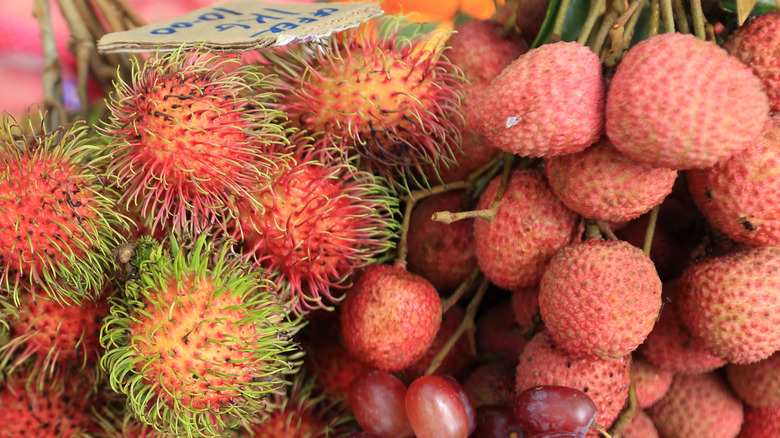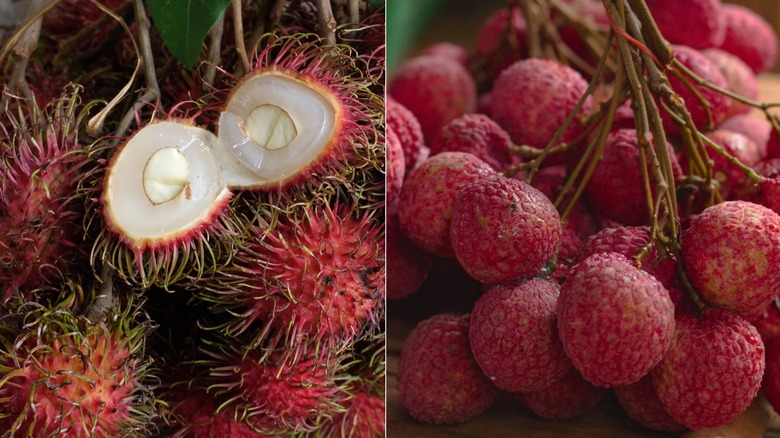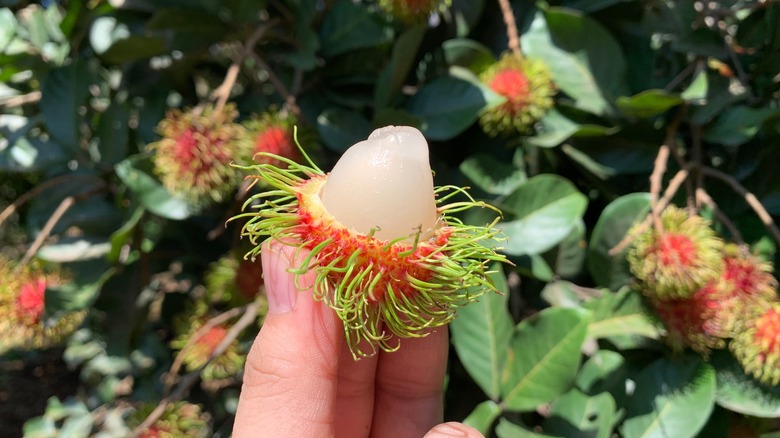Rambutans Vs Lychees: What Sets Them Apart?
Rambutans and lychees (seen left and right) are tropical fruits that rival the exuberance of designer ones like pink pineapples or sweet and juicy cotton candy grapes. While the two have interesting-looking exteriors with deep red hues — and the adventurous sort may gravitate towards the former with its dramatic-looking covering of thin spines — they are quite similar in taste and appearance on the inside.
Both rambutans and lychees belong to the soapberry (Sapindaceae) botanical family. Rambutan primarily hails from Malaysia and Indonesia, and wild lychee trees can be found in parts of Southern China, where the fruit originated. Presently, China is the largest producer of lychees, and Thailand produces some of the largest quantities of rambutan in the world. However, both fruits are now grown in several countries and there are even lychee plantations in Florida and Hawaii.
Rambutans are slightly more difficult to find than lychees because its growing season is shorter, but most Asian markets (and some major grocers) will carry them. Interestingly, rambutan and lychee are most easily distinguished by their skin and seed, still, both make for interesting eating experiences and there are subtle differences worth sussing out.
Lychees and rambutans are pretty and pretty different in appearance
The first thing you'll notice setting the two side-by-side is a significant size difference. A ripe rambutan is roughly equal to a golf ball, and about twice as large as a lychee. And since both fruits have a single, similarly-sized pit in the middle, you generally get more flesh per fruit in a rambutan. The tradeoff is that the smooth black pit within a lychee is much easier to remove; a rambutan pit has a rougher, more woody covering, which is fussier to separate from the flesh.
A ripe, unpeeled lychee has a scaly and brittle skin that's usually deep pink or red. The translucent white flesh inside surrounds a single large seed. A rambutan, on the other hand, has a red exterior covered with soft green and red spines. It's resemblance to a sea urchin is intimidating but the fruit is actually easier to peel than a lychee. A rambutan's brittle skin usually comes off in small chunks, and can sometimes feel like peeling a boiled egg; this is because its skin is softer and more readily slips off the fruit once an incision is made.
When peeling either fruit, be prepared for sticky fingers since they're both bursting with sweet juice. To pick out the best ones, look for plump specimens with a bright, red color. If a lychee's skin or a rambutan's hair appear dark brown or black, they're likely overripe.
Lychee vs rambutan: flavor and texture
Lychees and rambutans have similar tasting and aromatic notes but with varying intensities. The flavors in lychees tend to be more extreme, and a bite will reward you with intensely sweet, floral notes. It is also the tangier of the two fruits, and could almost be described as tart. While the lychee's taste is unique, if you're trying to imagine it, think of a mix between sweet melon notes and the tanginess of red grapes. This punchy flavor makes it great for infusing and using in summer cocktails. Rambutan, on the other hand, channels lighter flavors and has a milder version of the distinct floral sweetness found in lychee. It is also not as tart but does have a hint of tanginess.
Lychee flesh has a smooth, crisp texture that explodes with sweet juice when bitten. It is also the juicier of the two fruits. Regarding texture, the rambutan has a softer feel that is creamy rather than crisp (much like dragonfruit). Since neither fruit ripens once it's plucked, they must be at their peak when you buy them. Both are delicate and must be eaten within a few days. You can also refrigerate lychees and rambutans, but be sure to use the correct fridge drawers to store them to avoid moisture building up and help prolong the life of these succulent tropical fruits.


